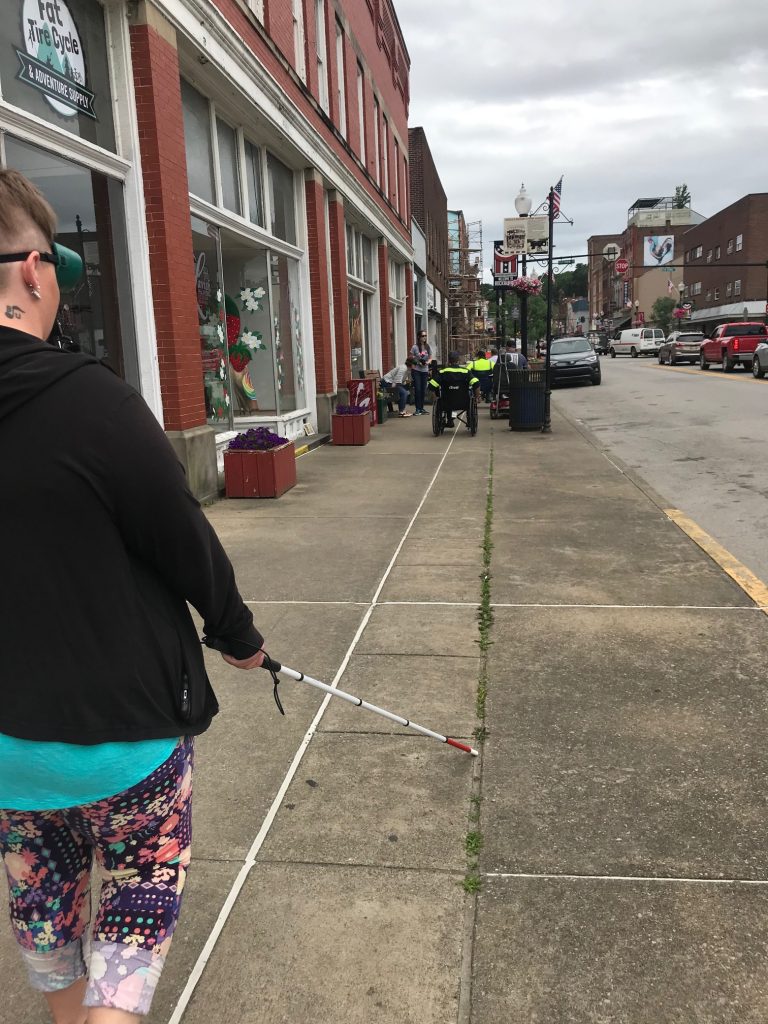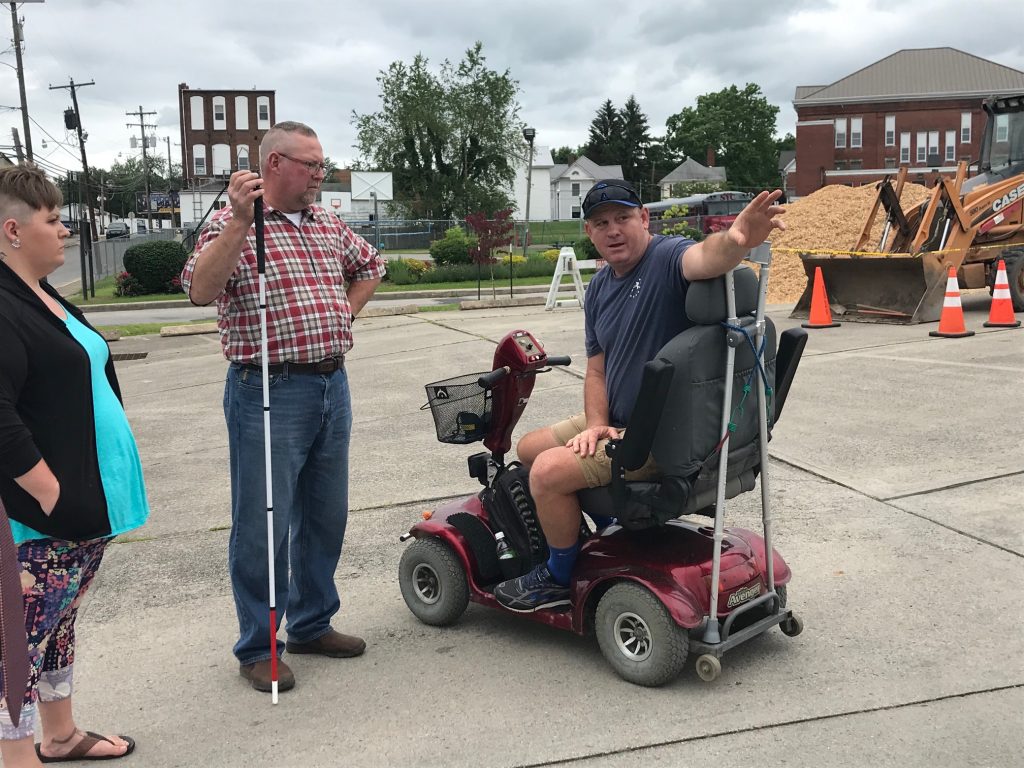City of Buckhannon holds an ADA Awareness Exercise
June 11, 2019
BUCKHANNON, WV: On Monday, community members and City staff learned from residents who live with a disability about how city infrastructure can either improve or hinder their mobility. Following a seminar and panel discussion at the Public Safety Complex, participants headed out on foot or on wheels to experience firsthand what a person living with a visual or physical impairment might experience on a daily basis.
Participants who normally enjoy the ability to walk and see had to navigate the terrain while using a wheelchair or without sight, with the goal of raising awareness about the challenges faced by those whose mobility or vision is limited.

Jerry Arnold, Public Works Director, organized the event and invited City staff, council, and community members to participate. Mayor McCauley provided opening remarks noting the need for inclusive infrastructure that is welcoming to all our residents.

Dr. Ronald Eck, representing the West Virginia Local Technical Assistance Program (LTAP), spoke about the history of the Americans with Disabilities Act and how it affects infrastructure design and construction.




Shayla Gowers, City Mapping Technician, and Jerry Arnold, Public Works Director, listen to City resident Keith Wolverton discuss the need for ADA accessible sidewalks on additional streets, especially Florida and Marion. Wolverton also noted the need for stop signs to calm traffic, as the new stop on Florida Street adjacent to Jawbone Park has done.
Residents Christina Romine, BJ Samples, Keith Wolverton, and Dave Thomas formed a guest panel, each discussing their personal experiences with local infrastructure and interactions with drivers of motor vehicles, both good and bad.
Then, attendees toured the downtown area with devices to limit their sight or mobility. Jerry Arnold led the tour and noted both the recent successes and areas that still need improvement. The event concluded with a survey that asked what types of improvements the participants would like to see the Streets & Parks Department prioritize when planning for future sidewalk and street projects.

The City of Buckhannon Streets & Parks Department maintains ten municipal parks, 26 miles of streets, 19 miles of sidewalks, seven parking lots, and the River Walk & River View trails, equaling 3,800,000 square feet of paved surface in streets and 400,000 square feet in sidewalks. This considerable infrastructure attracts residents, businesses, and tourists to the City, increasing quality of life and enhancing the local economic environment. Maintaining this vital infrastructure requires a considerable financial commitment, but the benefits far outweigh the investment. Afterall, where would we be without our streets, sidewalks, trails, and parks?
If you were unable to attend the event, you may still weigh in by either calling Buckhannon City Hall, attending a City Council, Consolidated Public Works Board, or Planning Commission meeting, or use the iWorq Citizen Engagement tool online.
CITY OF BUCKHANNON – MAYOR’S REMARKS AT
ADA WORKSHOP AT COMMUNITY & TRAINING ROOM – June 10, 2019
It’s my great pleasure to welcome you to this wonderful workshop today. I applaud Jerry Arnold for putting on such a terrific exercise for us. For going on 37 years now, I have sought to advance inclusivity in our community. Until 37 months ago, I didn’t have a pulpit upon which to preach, I just made subtle suggestions; but as mayor, I get to address captive audiences such as this one- about such things as today’s exercise. What a lucky bunch you are, right?! Before we can understand inclusivity, I think we first need to come to terms with exclusivity.
Imagine if you will- that we have 36 attendees today, & I decide to invest my own resources to purchase two dozen, that’s 24- donuts. There are more people than I have brought donuts. So- there has to be some selection process as to who gets a donut & who misses out, & we’ll assume everyone loves, and wants a donut. Perhaps I choose to take care of my friends first, or perhaps I choose to dole out the donuts to people who are most like me first. Perhaps I am afflicted with the Messiah complex, & I want to be kind & benevolent & I’m going to take care of the young, the aged, & the more challenged folks first. Maybe it’s totally random selection, & two out of three people get a donut, but the third person is out.
Now let’s complicate the donut mess, & I spend City funds to procure the donuts. These are not my resources, but come from the public till. And let’s say this donut doling out becomes a daily routine, & the same folks always end up with the donuts, & the same folks always seem to end up not getting the donuts. After some time, I give up donut doling, but right before I hang it up, I train the next donut doler-outer. The donut distribution policy continues on & on & on the same way it’s always been.
Now let’s say you’re one of the folks who chronically misses out on the donuts. How does this make you feel? You don’t get what others always seem to get. That’s exclusion friends. Maybe some of the regular donut recipients start to taunt you with the fact that they always get the donuts. “I must be special! I’ve got donuts! You don’t have any donuts! I must be part of the empowered group, because as you see, I get donuts!” In addition, to assertions of supremacy, now some of the empowered donut getting group members start to bully the non-donut recipients. Perhaps name calling ensues, & pretty soon, the non-donut group is relegated to not receiving other things. Perhaps they move to their own part of town, or dejectedly & collectively, put their heads down & stay to themselves, not venturing into public areas due to the stigma over being non-donut recipients all the while feeling like second class citizens.
They don’t dine in the local restaurants & particularly not the donut stores. They don’t shop much in the local places, nor do much of anything in town, so that segment of the community, is pretty much discounted & isolated from participation in virtually everything.
The divide grows deeper & deeper. Some of the non-donut members start to question the system. They talk & organize, & are immediately labeled by the majority of donut getters as people seeking handouts, discounted as negative stirrers of the pot. They are branded as trouble makers. But a funny thing happens, some of the donut getters start to think a little deeper about the inequities of the donut system. Why can’t everyone get some donuts? In fact, given all that’s happened with the donut deprivation, perhaps there ought to be some thought given to giving the donut deprived, a few extra donuts to atone a bit for the wrongful conduct that the entire donut getting society has allowed to occur for ages. “Let’s make some accommodations!”- this group says. Eventually, the donut getters allying with the donut deprived equals or exceeds the donut getters that want to preserve the old donut system.
The alliance runs candidates & elects representatives that think like they do, that is, that everyone should be treated the same. All kinds of old, outdated policies come to be questioned. The donut deprived start to take out loans from their allies & open up their own bakeries that make better donuts, with sprinkles & amazing cream fillings, & new icings! The old donut places are challenged to improve their donuts to compete. Some of them just can’t cut it, & close up grousing about how horrible it was that the donut deprived rose up like they did causing them to fail. The allies whisper- “What goes around, comes around.”
In this one town, they have a lot of people who like donuts. So, they make a huge table with a lot of seats, & everyone gets invited to the table, even the ones who technically have to pull their scooters up to the table. They may have to make the legs on the table a tad higher or lower to accommodate those scooter folks, but- just having everyone at the table together brings such tremendous value to discussions about how to improve their shared community, a little inconvenience or slight expense to reasonably accommodate is trivial compared to the incredible shared opportunity that’s created. Some of the scooter people have the best ideas!
This huge, amazing table is crowded with enthusiastic folks of all colors, ethnicities, & religions. Ladies are valued every bit as much as gentlemen. Older folks feel welcome, & they share stories with kids while learning a few things themselves from those young ones. There are even some rainbow flag waving people in the community, & of course they’re invited to the table, too, after all, who doesn’t like donuts? All of these folks talk around the table, break bread together at the table, & come to be friends. If some of them are going through a tough time, the others rally around their friends, lifting them up, helping them through their crisis. In one way or another, they all support one another- they spend their hard-earned cash in their friends’ stores, & use their friends’ services. This town might be called Donutville, or it might be called Utopia- but I think we should just call it … Sunnybuck. I hear tell they have a mighty big table there, & it’s a place that practices- wait for it… Wait… WAIT!- “We’re all in it together!”
Today’s exercise is all about empathy & inclusivity. It’s about recognizing that we as a community can always do better by those who are physically or mentally challenged, or those who due to age may not be as spry as they once were, & who we can make getting around a bit easier. We should always be ready to spring to action to make reasonable accommodations for everyone. We are all better when we have an “everyone!” Thanks for being here this morning!
Media: Callie Cronin-Sams, callie.csams@buckhannonwv.org or (304) 472-1651 ext. 1052